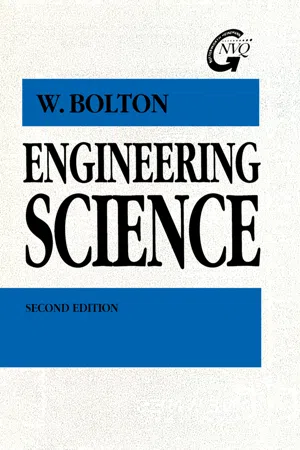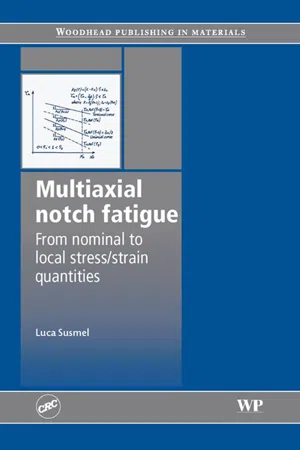Technology & Engineering
Mean Stress
Mean stress refers to the average stress experienced by a material over a given period of time. In engineering, it is an important factor in fatigue analysis and design, as it can contribute to material failure under cyclic loading. Understanding and managing mean stress is crucial for ensuring the structural integrity and longevity of engineering components.
Written by Perlego with AI-assistance
Related key terms
1 of 5
5 Key excerpts on "Mean Stress"
- Jonathan Wickert, Kemper Lewis, Jonathan Wickert(Authors)
- 2020(Publication Date)
- Cengage Learning EMEA(Publisher)
With those thoughts in mind, you can see that the circumstances for a mechanical component to break, stretch, or bend depend not only on the forces applied to it, but also on its dimensions and the properties of the material from which it is made. Those considerations give rise to the concept of stress as a measure of the intensity of a force applied over a certain area. Conversely, the strength of a material describes its ability to support and withstand the stress applied to it. Engineers compare the stress present in a component to the strength of its material in order to determine whether the design is satisfactory. As an example, the broken crankshaft shown in Figure 5.1 was removed from a single-cylinder internal-combustion engine. This failure was accelerated by the presence of sharp corners in the shaft’s rectangular keyway, which is used to transfer torque between the shaft and a gear or pulley. The spiral shape of the fracture surface indicates that the shaft had been overloaded by a high torque prior to breaking. Engineers are able to combine their knowledge of forces, materials, and dimensions in order to learn from past failures and to improve and evolve the design of new hardware. In this chapter, we will discuss some of the properties of engineering materials and examine the stresses that can develop within them. Within Stress Strength Element 4: Materials and stresses Keyway Shaft Fracture surface Figure 5.1 A broken crankshaft that was removed from a single-cylinder internal-combustion engine. Image courtesy of the authors. Copyright 2021 Cengage Learning. All Rights Reserved. May not be copied, scanned, or duplicated, in whole or in part. Due to electronic rights, some third party content may be suppressed from the eBook and/or eChapter(s). Editorial review has deemed that any suppressed content does not materially affect the overall learning experience.- eBook - PDF
- William Bolton(Author)
- 2016(Publication Date)
- Newnes(Publisher)
6 Stress and strain Stress When a material is subject to external forces, such as those applied to stretch it, then internal forces are set up which oppose the external forces. The material can be considered to be rather like a spring. A spring is stretched by external forces, it sets up internal opposing forces which are readily apparent when the spring is released and they force it to contract. A measure of the intensity of the internal forces in a material created as a result of external forces being applied is stress. Stress is defined as the external force acting per unit area: The unit of stress is the pascal (Pa), where 1 Pa = 1 N/m 2 . Multiples of the pascal are generally used, e.g. the megapascal (MPa) which is 10 6 Pa and the gigapascal (GPa) which is 10 9 Pa. Because the area over which the forces act is more generally mm 2 rather than m 2 , it is useful to recognize that 1 GPa = 1 GN/m 2 = 1 kN/mm 2 and 1 MPa = 1 MN/m 2 = 1 N/mm 2 . The stress is said to be a direct stress when the area being stressed is at right angles to the line of action of the external forces. This is the case with materials in tension or in compression. A material in tension has had its length in the direction of the external forces increased; when in compression it is shortened. The convention is to designate tensile stresses as positive and compressive stresses as negative. Shear stresses are not direct stresses, the forces being applied in the same plane as the area being stressed (see later this chapter). The area used in the calculation of the stress is generally the original area that existed before the stress occurred. This stress is sometimes referred to as the engineering stress. The true stress would be the force divided by the actual area existing in the stressed state. Example 1 A bar of material with a cross-sectional area of 50 mm 2 was subjected to tensile forces of 0.1 kN. - eBook - PDF
Applied Mechanics
Made Simple
- George E. Drabble(Author)
- 2013(Publication Date)
- Made Simple(Publisher)
CHAPTER EIGHT BEHAVIOUR OF MATERIALS: STRESS ANALYSIS Since an engineer is almost always concerned with making something, one of the most important aspects of his profession relates to the nature, pro-perties and diversity of the various materials available to him. The properties that are of the most direct interest are strength, stiffness, workability, resis-tance to corrosion, resistance to abrasion, and appearance. Applied mech-anics is concerned with strength and stiffness only. In a sense, one can say that these two properties are the most important because they determine the ability of the material to perform the job it is called upon to do, although other properties may have a contributory effect. Engineering components usually fail because they break or deform under the load imposed upon them, either because this load is greater than the designer anticipated, or because of some unforseeable overload, or even, perhaps, because the designer failed to allow for load at all in his design. The Tay Bridge disaster of 1879 was due principally to a gross underestimate of the wind force on the bridge. The collapse of a building due to an earthquake or bomb is an example of an unforseeable overload. Failure to allow for load at all is not uncommon in the design and manufacture of many cheap kitchen gadgets and children's toys. An essential requirement of any engineering material is that it should behave satisfactorily under load. This does not mean merely that the com-ponent must not break: it must not deform beyond a certain acceptable limit. It would be quite possible to design and erect a perfectly safe road bridge of strong rubber stretched between the abutments, but it would be a matter of considerable difficulty, and understandably so, to induce any driver to make use of it. The examination of these properties of strength and stiffness is called stress analysis. This has superseded the earlier, and perhaps more familiar name of 'strength of materials'. - eBook - ePub
- Luca Susmel(Author)
- 2009(Publication Date)
- Woodhead Publishing(Publisher)
Independently of the approach adopted to perform the fatigue assessment, the starting point of any fatigue life estimation technique is the location of the components’ weakest points. At such points the stress/strain states have to be determined using either classical continuum mechanics or numerical approaches, typically the Finite Element (FE) method. Subsequently, such stress/strain states have to be recalculated in terms of quantities suitable for being used along with the adopted fatigue criterion. In other words, stress/strain states have to be expressed in terms of amplitudes, mean values, ranges, etc., to correctly estimate fatigue damage. The aim of this chapter is to review the procedures commonly used in practice to determine the above quantities. In particular, in order to properly deal with multiaxial fatigue situations, the problem of determining the stress components relative to the so-called critical plane will be addressed in great detail. Subsequent chapters of this book will focus on means of using such quantities to properly assess mechanical components. Finally, the present chapter also reviews some analytical tools suitable for performing the stress analysis in the presence of stress concentration phenomena.1.2 Stress state
Consider a body loaded by an external system of forces. In order to constrain the required degrees of freedom, the appropriate boundary conditions are also applied to such a body (Fig. 1.1 ). Consider now a generic material point O , which is also the origin of a convenient frame of reference, Oxyz . The stress state at this material point is fully described by the following tensor:1.1 Body subjected to an external system of forces and definition of the frame of reference at point O .1.1[ σ ]=[]σ xτx yτx zτx yσ yτy zτx zτy zσ z1.1whereσ x,σyandσ zare the normal andτ xy,τxzandτ yz - eBook - PDF
- P. G. Forrest(Author)
- 2013(Publication Date)
- Pergamon(Publisher)
C H A P T E R I V THE INFLUENCE OF S T R E S S CON-D I T I O N S ON F A T I G U E STRENGTH IN Chapter III, in comparing the fatigue strengths of different materials, only results determined under simple alternating stresses on plain polished specimens were considered. In this chapter, the influence of the more com-plex stress conditions often occurring in practice will be discussed. These include the effect of a Mean Stress superimposed on an alternating stress, combined shear and tensile stresses, stress cycles of varying amplitude and the frequency of the stress cycle. The influence of Mean Stress By far the greatest proportion of fatigue data available have been de-termined from alternating stress tests, that is with the Mean Stress of the cycle equal to zero. This is largely a matter of convenience because fatigue data are most easily obtained from rotating bending machines which do not permit the application of a Mean Stress. In practice, however, many com-ponents and structures are subjected to stresses which fluctuate between different values of tension and compression. The most important condition to be considered is the influence of a static tensile stress superimposed on an alternating tension-compression stress, but even for this condition, there are relatively few data. A number of empirical relations have there-fore been put forward which enable an estimate to be made of the fluctua-ting fatigue strength if the alternating fatigue strength and the tensile strength of the material are known. Empirical Relations for Predicting Fatigue Strength under Fluctuating Stresses The fatigue strength of a material under fluctuating stresses, that is with a static stress superimposed on the alternating stress, can be represented on a diagram in which the alternating stress S a is plotted against the static or Mean Stress S my as in Fig. 48. This is sometimes known as an R-M diagram, where R is the range of stress, equal to twice the alternating stress.
Index pages curate the most relevant extracts from our library of academic textbooks. They’ve been created using an in-house natural language model (NLM), each adding context and meaning to key research topics.




